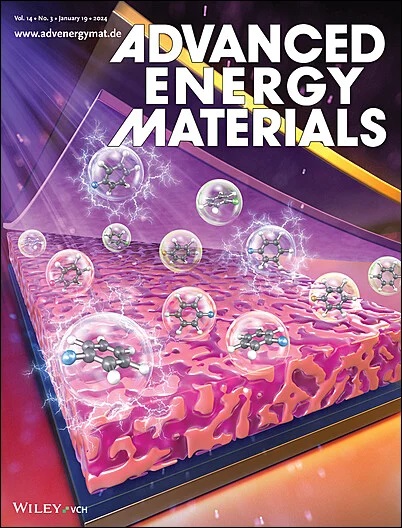Customized Design of R-SO3H-Containing Binders for Durable Iodine-Loading Cathode of Zinc–Iodine Batteries
IF 24.4
1区 材料科学
Q1 CHEMISTRY, PHYSICAL
引用次数: 0
Abstract
The challenges of iodine dissolution and polyiodide shuttle behavior severely hinder the development of zinc–iodine batteries (ZIBs). Among the battery components, binders play a vital role in maintaining mechanical integrity and facilitating the iodine conversion reaction of the iodine-loading cathode in ZIBs. Herein, a series of polyimide-based polymers rich in the sulfonic acid group (R-SO3H) are elaborately designed as functional binders for iodine-loading cathodes. According to the spectroscopic characterization and theoretical calculation results, PI-4S binder with R-SO3H, hydroxyl and imide groups holds stronger chemisorption capability for I2/I−/I3− species, which effectively helps to block the polyiodide shuttle and the active iodine's dissolution behavior. As a result, the corresponding ZIBs with PI-4S as binders deliver a reversible capacity of 142.7 mAh g−1 over 600 cycles at 0.2 A g−1, a high capacity of 157.6 mAh g−1 over 500 cycles at 0.5 A g−1 at 50 °C, and durable cycling stability of 88 mAh g−1 over 15000 cycles at 4 A g−1. This work guides the autonomous design of multifunctional polymer binders for iodine-loading cathodes and facilitates the practical application of ZIBs.

定制设计含 R-SO3H 的粘合剂,用于锌碘电池的耐用碘负荷阴极
本文章由计算机程序翻译,如有差异,请以英文原文为准。
求助全文
约1分钟内获得全文
求助全文
来源期刊

Advanced Energy Materials
CHEMISTRY, PHYSICAL-ENERGY & FUELS
CiteScore
41.90
自引率
4.00%
发文量
889
审稿时长
1.4 months
期刊介绍:
Established in 2011, Advanced Energy Materials is an international, interdisciplinary, English-language journal that focuses on materials used in energy harvesting, conversion, and storage. It is regarded as a top-quality journal alongside Advanced Materials, Advanced Functional Materials, and Small.
With a 2022 Impact Factor of 27.8, Advanced Energy Materials is considered a prime source for the best energy-related research. The journal covers a wide range of topics in energy-related research, including organic and inorganic photovoltaics, batteries and supercapacitors, fuel cells, hydrogen generation and storage, thermoelectrics, water splitting and photocatalysis, solar fuels and thermosolar power, magnetocalorics, and piezoelectronics.
The readership of Advanced Energy Materials includes materials scientists, chemists, physicists, and engineers in both academia and industry. The journal is indexed in various databases and collections, such as Advanced Technologies & Aerospace Database, FIZ Karlsruhe, INSPEC (IET), Science Citation Index Expanded, Technology Collection, and Web of Science, among others.
 求助内容:
求助内容: 应助结果提醒方式:
应助结果提醒方式:


